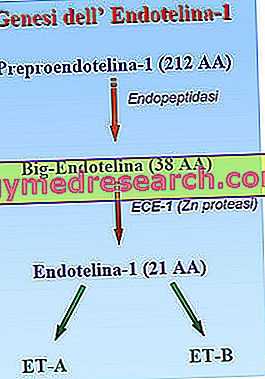Key points
Lymphangitis (or blood poisoning) is an inflammation of the lymphatic vessels with a predominantly bacterial etiology.
Lymphangitis: causes
Most of the diagnosed lymphangitis is triggered by streptococci. Also other pathogens can trigger lymphangitis: staphylococci, Spirillum minus, Brugia malayi, Pasteurella multocida and Wuchereria bancrofti .
Lymphangitis: symptoms
The most recurrent symptoms in lymphangitis are: chills, headache, stabbing and continuous pain along the affected area, muscle pain, edema, fever, loss of appetite, swollen lymph nodes, malaise, perception of heat in the area affected by the disease and tachycardia. Complications: suppurative and septicemic.
Lymphangitis: therapies
Bacterial lymphangitis should be treated with antibiotics. If necessary, take anti-inflammatory and analgesic drugs to reduce inflammation and pain. In case of complications (eg abscess) surgery is required.
Lymphangitis: definition
"Lymphangitis" means any inflammation of the lymphatic vessels, the cause of which often resides in a bacterial infection. Synonymous with poisoning or blood poisoning, lymphangitis is a condition so well known as feared that it must be urgently treated. In most cases, lymphangitis affects the limbs; nevertheless, the extensive network of lymphatic capillaries favors the rapid spread of inflammation in the various districts of the body.
The distinctive signs and symptoms of lymphangitis are evident: abscesses, burning, edema, fever, skin irritation, lymphedemas and reddish striae are just some of the most frequent symptoms common to the various forms of lymphangitis. Treatment of inflammation of the lymphatic vessels must be rapid to avoid the dissemination of pathogens; the antibiotics constitute in this sense the therapy of choice. The treatment for the non-infectious forms of lymphangitis is instead subordinated to the cause that arises at its origins.

Causes
It is customary to speak of lymphangitis referring exclusively to an inflammation of the lymphatic vessels caused by bacterial insults. In fact, nematodes and other pests can also cause lymphangitis.
In humans, the most common cause of lymphangitis lies in bacterial infections, in particular supported by group A beta-hemolytic streptococci ( Streptococcus pyogenes ). Less often, bacterial lymphangitis is triggered by a staphylococcal infection. In the etiopathogenesis of lymphangitis other possible pathogens have been identified: Spirillum minus (bacterium), Brugia malayi (nematode), Pasteurella multocida (bacterium) and Wuchereria bancrofti (nematode).
Patients with diabetes, chicken pox or systemic diseases, or who make extensive use of steroid drugs, are more prone to lymphangitis. Immunocompromised patients are also particularly at risk.
Pathogens, found in the complex lymphatic network, move towards the lymph nodes, where they cause damage and inflammation.
Step back to understand ...
Let us remember briefly that the lymph nodes are very important "filtering" organs located along the lymphatic pathways: the lymph nodes produce lymphocytes: white blood cells responsible for eliminating pathogens. In the case of bacterial infection, the lymph nodes produce large quantities of lymphocytes: by doing so, they increase in volume and become painful to the touch.
Classification
Lymphangitis can be divided into several variants:
- Acute lymphangitis (includes three other variants):
- Reticular diffuse lymphangitis: it is characterized by the formation of a so-called "reticular" edema filled with leukocytes
- Erysipeloid diffuse lymphangitis: erysipelas is an acute cutaneous infection involving dermis, hypodermis and lymphatic vessels
- Troncular diffuse lymphangitis: this form of lymphangitis - involving a superficial lymphatic collector - is typical of the limbs and manifests itself with characteristic reddish striae in the inner part of the limbs involved. Often, patients with diffuse lymphangitis experience complications (eg abscess, lymphedema, etc.), which occur more often in immunocompromised (gangrene, suppurative processes). In similar circumstances, the disease can easily be confused by necrotizing fasciitis.
- Chronic lymphangitis: the protagonists of the chronic forms of lymphangitis are the parasites. In similar situations, the walls of the lymphatic vessels become enlarged disproportionately, completely blocking the lumen. Chronic forms are generally triggered by tuberculosis ( Mycobacterium tuberculosis ), syphilis ( Treponema pallidum ) and filaria ( Dirofilaria immitis ). Chronic lymphangitis can also be induced by fungal infections.
Lymphangitis: symptoms
In typical cases, the lymphangitis bursts in correspondence of wounds or lesions, which serve as entrance doors for pathogens. Also abscesses and infectious cellulitis are predisposing factors for lymphangitis.
The onset symptoms of lymphangitis are the reddish striae, which occur particularly in the inner area of the arms and legs. Subsequently, a series of chain symptoms can be observed:
- Chills
- Headache
- Shooting and continuous pain along the affected area
- Muscle pains
- Edema
- Temperature
- lack of appetite
- Enlarged lymph nodes
- General malaise
- Perception of heat in the area affected by the condition
- Tachycardia (especially in children)
The chronic forms of lymphangitis can favor the appearance of a peripheral edema associated with deposition of a fibrosclerotic component *, up to evolving into elephantiasis.
The lymphangitis triggered by the tuberculosis bacterium can easily degenerate to the formation of fistulas.
Possible complications of suppurative and septicemic (septic shock).
* fibrosclerosis: increase in the consistency of a tissue caused by fibrosis. Fibrosis is an exaggerated increase in the fibrous connective component of a tissue (to the detriment of parenchymal cells).
Diagnosis and therapies
The diagnosis is based on physical examination: the doctor proceeds with palpation of the lymph nodes and with the analysis of signs and symptoms reported by the patient. Biopsy of a portion of infected tissue can clarify the underlying cause. Even blood culture can be performed to ascertain whether the infection has spread to the bloodstream.
The differential diagnosis with thrombophlebitis is important: in fact, it is not uncommon for the two clinical conditions to be confused.
The patient should undergo the diagnostic investigation within the shortest possible time from the onset of symptoms. In fact, the infection can spread in a few hours.
Antibiotics - first of all broadly based, then specific - are the treatment of choice for the treatment of bacterial lymphangitis. Next to antibiotic therapy it is recommended to take anti-inflammatory and analgesic drugs, useful for reducing inflammation and masking pain. Even compresses made with a cloth soaked in warm water are indicated to reduce the healing time of lymphangitis. Surgical treatment is recommended to treat severe lymphangitis complications (eg abscess).



